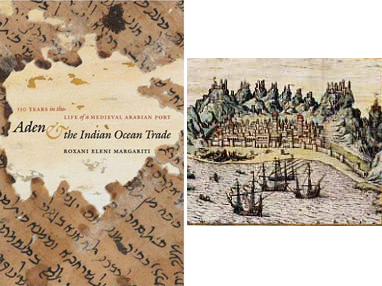
[The following is an excerpt from a recently published historical analysis of the Yemeni port of Aden in the 13th and 14th centuries by Roxani Margariti (Emory University), who reconstructs port life vividly through archival records in the Cairo Genizeh, relevant Arabic texts and archaeological research. This is a fascinating look at one of the most important medieval ports in the Red Sea/Indian Ocean trading network that ultimately linked Europe with the Far East before Portuguese galleons changed the complex equation of global trade.]
In the current era of giant container ships, GPS, and e-commerce, a single vessel can carry forty-eight hundred trailer-sized containers of merchandize from Bremen, Germany, to Elizabeth, New Jersey, in a single voyage. The exact position of a ship is knowable at the push of a button and the blink of any eye, and one can place an order one minute and have confirmation of its receipt in the next. It is therefore difficult to grasp the medieval dimensions of dimensions and time. A respectably sized medieval Arab ship held the equivalent of about two trailer-sized containers. At least two years, often more, were required for a round-trip voyage from Egypt to India. An order for Western merchandize sent from India to Aden in early spring would not be fulfilled until the following September at the earliest. And when a ship belonging to Halfon, the son of Madmum b. Japheth, mysteriously foundered off the South Arabian coast, four days’ sail from Aden, news of its fate did not reach its home port until six months later. Adeni officials spent two years gathering information and testimonies before composing an official account of the events for the relatives of Alexandrian victims on board; that letter must have reached Alexandria about half a year after that..
Vast geographical scope and limited, even precarious, means of transportation and communication, compromised efficacy and safety in the conduct of overseas trade. The effects of distance and time somehow had to be mitigated. Moreover, even in a commercial culture based on the trust inherent in family relations and all-meaningful social bonds, all participants had to be held answerable for their actions, at least to some degree. By virtue of their geographical location and through formal and informal institutions, major entrepôts provided the organization and tools necessary to overcome the difficulties and risks of protracted travel and to track long-distance transactions.
Located at critical junctions of important trade routes, port cities allowed merchants to break up a physical journey into shorter, more manageable jaunts. Services and organization within the entrepôt enabled both individuals and entire networks to divide what would have been single extenuated business ventures into safer, more circumscribed transactions…
This book has amply emphasized the notion that during the period under investigation here, Aden stood at a maritime gateway of East and West, North and South, serving as the conduit for an increasingly integrated global trade system that linked the worlds of the Mediterranean Sea and the Indian Ocean.
[Excerpt from Roxani Eleni Margariti, Aden and the Indian Ocean Trade: 150 Years in the Life of a Medieval Arabian Port. Chapel Hill: University of North Carolina Press, 2007, pp. 177, 213]